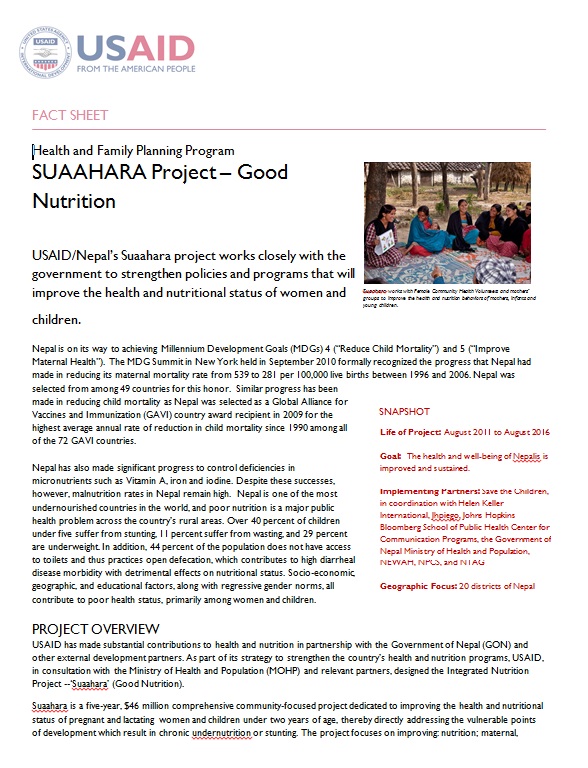USAID/Nepal's Suaahara project works closely with the government to strengthen policies and programs that improve the health and nutritional status of women and children.
SUAAHARA Project – Good Nutrition ![]() (docx - 419k)
(docx - 419k)
Nepal is one of the most under-nourished countries in the world and poor nutrition features as a major public health problem across the country’s rural areas. Over 40% of children under the age of five suffer from stunting, 11% of children suffer from wasting and 29% are underweight. Moreover, the rate of stunting is found to be as high as 60% among disadvantaged groups.
Nepal has made significant progress in controlling micro-nutrient deficiencies of essential dietary components such as vitamin A, iron, and iodine. Despite these successes, there is still an ongoing problem of protein energy malnutrition (general malnutrition). Good nutrition starts during pregnancy. Due to the lack of awareness and poor access to health services, only 58% of women in Nepal receive antenatal care during pregnancy, and only 36% of deliveries are assisted by a skilled birth attendant (SBA). The low level of supervised antenatal and postnatal care and poor maternal nutrition directly contributes to higher maternal mortality rates. In addition, 44% of the population does not have access to toilets, and open defecation contributes to higher diarrheal disease morbidity, with further detrimental effects on nutritional status. Socio-economic, geographic, and educational factors, along with regressive gender norms, contribute to the poor health status of Nepalis, particularly women and children.
PROGRAM OVERVIEW
USAID has made substantial contributions to health and nutrition, in partnership with the Government of Nepal (GON) and other development partners. As part of its strategy to strengthen the country’s health and nutrition programs, USAID, in consultation with the Ministry of Health and Population (MOH) and other relevant partners, designed the Integrated Nutrition Project now known as Suaahara (Good Nutrition).
Suaahara is a five-year, comprehensive, community-focused project dedicated to improving the health and nutritional status of pregnant and lactating women and children under the age of two. The project focuses on improving nutrition and health standards of women and children by focusing on better maternal, newborn, and child health services. It aims to improve reproductive health/family planning services; create awareness regarding sanitation and hygiene; improve access to clean water; and introduce home-based gardening as a way to encourage a balanced and healthy diet. Moreover, it also works on influencing positive behavioral changes through planned communication campaigns in 41 districts.
Suaahara's unique approach is based on applying the latest evidence-based interventions in health, nutrition, family planning, water, sanitation and hygiene, backyard poultry, and food production at scale in over half of the districts in Nepal. Another unique aspect of Suaahara is its success at targeting disadvantaged groups that have significantly lower levels of income, seek health services less frequently, and subsequently suffer poor health and nutrition outcomes compared to other groups. The project works in collaboration with the GON, primarily through Female Community Health Volunteers (FCHVs) and other Community Extension Workers.
PROGRAM ACTIVITIES
- Organize regular visits and follow-up by FCHVs of households, particularly those of disadvantaged groups who have children under two or pregnant women
- Organize and facilitate mothers' group interactions to promote dialogue and raise awareness regarding better health and nutrition practices for women and children
- Use smartphones to track coverage of disadvantaged households and monitor the degree to which Suaahara has reached these households with interventions
- Improve the survival of mothers and their children by providing effective counseling on healthy timing and spacing of pregnancies
- Improve mothers’ infant and young child feeding knowledge and behaviors
- Increase year-round access to nutritious foods to improve the nutritional status of children under two years of age and their mothers
- Enhance clean water, sanitation, and hygiene conditions by promoting household facilities and community sanitation norms
- Improve the food security of households by increasing the diversity of foods grown and consumed at home
- Use communication campaigns like the Bhanchhin Aama radio program to influence social and behavioral change in health and nutrition practices of 1,000-day mothers (pregnant and breastfeeding women, and mothers with children under two years of age)
- Provide nutritional counseling to 1,000-day households
- Offer training to plant and maintain small, diversified gardens
- Offer support for poultry breeding to provide animal-source protein and increase incomes
- Offer training and support to build latrines, dispose of solid waste safely, and wash hands frequently
KEY RESULTS
- Improved household health and nutrition behaviors
- Increased use of quality nutrition and health services by women and children
- Increased prevalence of children of 6-23 months receiving a minimally acceptable diet from 23 to 59% in 2015
- Increased percent of children 6-23 months of age receiving minimum dietary diversity (foods from >4 food groups) during the previous day from 47 to 60% in 2015
- Helped Dalit families in focus districts earn an additional average of $3,500 per year in 2014-15 by selling excess vegetables and poultry
- Increased the prevalence of exclusive breastfeeding of children under 6 months from 46 to 69% in 2015
- Supported establishment of Food Security and Nutrition Steering Committee; the Nepal Nutrition Group; the Nutrition Technical Committee; the Nutrition Advisory Committee; the Safe Motherhood sub-committee; the Family Planning Sub-committee; and the Reproductive Health Coordination for improved coordination between government and other stakeholders
- Reduced stunting and the number of underweight children under two in 41 target districts








Comment
Make a general inquiry or suggest an improvement.